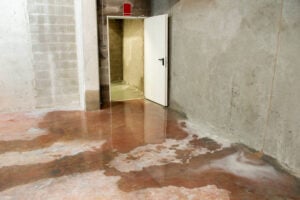Top Causes of Basement Flooding
(and How to Prevent Them)
 Basement flooding is one of the most common, and costly problems homeowners face. (It’s also one of our most common residential calls.) Whether it’s a few inches or a full-on flood, water in your basement can lead to mold growth, structural damage, and serious cleanup bills.
Basement flooding is one of the most common, and costly problems homeowners face. (It’s also one of our most common residential calls.) Whether it’s a few inches or a full-on flood, water in your basement can lead to mold growth, structural damage, and serious cleanup bills.
At MacFawn Fire and Flood Restoration, we’ve helped countless homeowners recover from water disasters. But the best protection starts with prevention. Here are the top causes of basement flooding and what you can do to avoid them:
1. Poor Drainage Around the Foundation
When water isn’t directed away from your home, it collects around the foundation and can seep into your basement.
>Prevention Tip: Make sure your gutters are clear, downspouts extend 6+ feet away from the house, and your yard is graded to slope away from the foundation.
2. Clogged or Broken Gutters
Gutters are your first line of defense against rainwater pooling near your home. When they’re clogged or damaged, water spills over and saturates the ground near your basement walls.
>Prevention Tip: Clean your gutters seasonally and inspect for damage after storms.
3. Sump Pump Failure
A sump pump is designed to pump water out of your basement during heavy rain or rising groundwater — but if it fails, you’re in trouble.
>Prevention Tip: Test your sump pump regularly and install a backup battery system in case of a power outage.
4. Cracks in the Foundation or Walls
Over time, water pressure or shifting soil can cause tiny cracks in your basement walls or floor. These cracks allow water to seep in slowly and silently.
>Prevention Tip: Inspect for cracks regularly and seal them with waterproof epoxy or professional foundation repair.
5. Sewer Backup or Drain Overflow
When the municipal sewer system becomes overloaded (often during heavy rain), it can back up into your basement through floor drains.
>Prevention Tip: Install a backwater valve to prevent sewage from flowing into your home, and avoid flushing anything non-biodegradable.
6. Plumbing Leaks or Burst Pipes
Sometimes the flooding isn’t from the outside at all. A leaking water heater, burst pipe, or broken washing machine hose can dump gallons of water into your basement in minutes.
>Prevention Tip: Inspect appliances and exposed plumbing regularly. During winter, insulate pipes to prevent freezing.
7. Window Well Leaks
If your basement has below-grade windows, water can easily collect in the wells and leak inside — especially if the drains are clogged.
>Prevention Tip: Keep window well drains clear and consider installing clear plastic covers to shield them from rain and debris.
Don’t Wait Until It’s Too Late
Even a “small” basement flood can lead to big problems like mold growth, structural damage, and destroyed belongings. If you’ve had water in your basement or want to make sure you never do — MacFawn is here to help.
Call MacFawn Fire and Flood Restoration at 877-622-3296
Learn more or request service at: macfawn.com
We’re available 24/7 for emergency response and offer professional water mitigation, drying, and mold remediation services.
MacFawn Fire and Flood Restoration
Reliable. Responsive. Restoration when you need it most.

